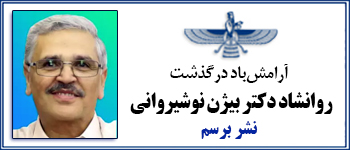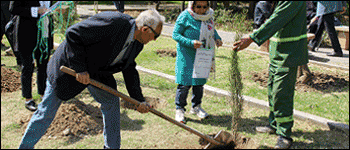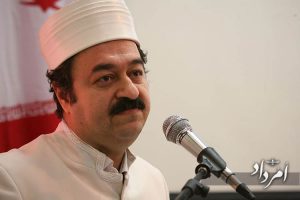Today is the blessed day of Sepandarmazd Amshaspand and Esfand month in the year 2758 of Zoroastrian calendar, the auspicious “Sepandarmazgan” the day for commemorating women, the Earth and fertility (Bahman 29, 1399 AH, February 17, 2021 AD).
In February 1954, the International Conference of National Anthem Experts in Vienna declared the anthem “O Iran” as very patriotic and exciting in content and melody. It emphasized that “O Iran” is by far most effective, motivating and patriotic, an anthem that by hearing it every Iranian is inspired to do any sacrifice for his homeland.
Hundreds of memorable tunes and songs have been left behind by Khaleghi. The most famous is “O Iran” which lyric was written by Hossein Gol-e Golab, an instructor at Tehran University, and a member of Iran cultural Center. This anthem was completed in 1323 AH (1944, during Iran’s military occupation by the Allies). Having to bear the insults from the occupying soldiers who had no idea of the Iranian history and civilization was the motivation for this poem. For centuries, Iran was the only superpower in the world, and for more than eight consecutive centuries, it was one of the two superpowers. In the middle ages, when the west was going through its dark ages, Iran shone as a superpower in literature, science, intellect and writings.
According to statistics, by the end of 1384 (2006) this anthem’s tape and CD was produced more than any other Persian song and anthem. It exists in the home of almost every Iranian, inside and outside the country. “O Iran, the land of gems abound, Thy soil nurtures artists aplenty, Far be from you the foes’ intentions, Thy love has become my preoccupation, My thoughts are never far from you, For thee my life is not worthy, May the land of Iran be eternal” is part of this anthem. Ruhollah Khaleghi was a musician, composer, and violinist who composed the unofficial national anthem “O Iran” and died of cancer in Austria, where he went for his treatment, on November 12, 1965, at 59. He was born 1285 AH, in Mahan, Kerman.
Khaleghi, who mastered all kinds of music theories and sound sciences, rendered valuable services in reviving the original Iranian music; including Chang-e Rudaki. He advised that Iranian music’s roots and lost Persian words should be sought among the Tajiks and the people of southern Russia and the North Caucasus.
The blessed day of Sepandarmazgan, the day of mother/woman, Earth and fertility (29 bahman and 5 Esfand in the Zoroastrian calendar).
In ancient Iran, among the Aryans, there was a day called the day of love “Sepandarmazgan or Esfandarmazgan.” In the Zoroastrian calendar, this day is equal to the fifth of Esfand month. In the Iranian solar calendar, which is considered the first six months of the year thirty-one days, it is six days ahead and precisely equal to Bahman 29, i.e., four days after Valentine’s Day. Zoroastrians celebrate Sepandarmaz “Sepandarmazgan – Women’s Day and Earth Day” every year on the fifth of Esfand month, equal to the 29th of Bahman AH.
Sepandarmaz is the name of the Earth in the material world, spreader of goodness and humility. The Earth is a symbol of compassion and fertility because it spreads love among all living beings together with humility and forgiveness. She looks upon all ugly and beautiful creatures from one eye and nurtures everyone like a mother in her loving arms. Hence, in the culture of ancient Iran, “Sepandarmaz” was considered a symbol of love. The suffix “gan” also means “celebration,” and as a result, “Sepandarmazgan” means “celebration of Sepandarmaz,” “celebration of the day of woman and earth.” “Sepandarmazgan” was a celebration of the Earth and cherished the creation of love, both of which found meaning together. The celebration of “Sepandarmazgan” or “Esfandegan” was a day of commemoration of women in ancient Iran.
As Iranians believed, the man has more of masculine power, power of thinking and reasoning. On the other hand, the woman has more compassion, pure love, virtue, and self-sacrifice. Each of these two alone cannot get anywhere, and even the process of the dynamics of the universe is brought to a standstill. Ashu Zarathushtra, the messenger of monotheism, considers human happiness to depend on the extent of human knowledge and wisdom, not on gender, ethnicity, color, and race. In his view, all human beings – all men and women – have equal rights. He considers girls to be free in choosing a spouse and considers pure love and adequate knowledge as the two foundations of life and considers the happiness of young couples in married life gained by trying to outdo each other in honesty and truthfulness.
The people of Iran are among the people whose lives have been closely linked to celebration and joy, celebrated on various occasions, and lived happily. These celebrations represent the culture, lifestyle, mood, philosophy of life, and worldview of the ancient Iranians.















